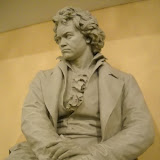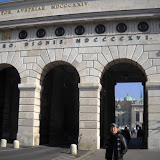| ("Beethoven lives next door.") |
In October 2010 my wife and I spent a week in Vienna. It was my intention to make this trip a "pilgrimage-slash-treasure-hunt" devoted to Beethoven. Well, it was very rewarding, but it also had its share of ups and downs! I definitely have enough unchecked boxes to make a second visit.
Considering that there are at least 50 Beethoven-related sites in Vienna, I think I made a good dent tho...
Part 1 - Flight to Vienna - Jarvi's Beethoven - Burg Theater(?) - Pasqualati House
Day 1
We flew Friday night from NYC to London/Heathrow, and then to Vienna airport. I listened to my German conversation mp3's on the plane. Fortunately almost everyone speaks English in Vienna! We had one very bumpy moment on the plane where I kept flashing back to the pilot episode of "Lost." I remembered that the guy named "Ed" on that show was knocked out by falling baggage (and eventually died) so I kept an eye on the overhead compartments. Anyways, we landed Saturday night without mishap and raced through customs because we had tickets to a concert at the Wiener Konzerthaus at 7:30pm and we had just landed at 6:30pm. After the cab driver took us to the wrong location (he kept thinking we were normal tourists and wanted to go to a hotel) we made it to the concert hall. The Wiener Konzerthaus ("Vienna Concerthouse") hall has the largest concert organ in Europe. It's historically used for more "modern" fare like Stockhausen and Ligeti, but tonite we were going to see the all-time revolutionary, Beethoven. I think the avant-garde element was that it was Paavo Jarvi conducting and that all the performers played like whirling dervishes.
Maestro Jarvi and the Deutsche Kammerphilharmonie Bremen opened the all-Beethoven set by blasting through the "Creatures of Prometheus" Overture, paused to tune up, and then launched into the most articulate and energetic 4th Symphony I'd ever heard. It didn't hurt that we had 2nd row seats. After a brief intermission where I had half of a Snickers bar as my dinner, we returned to our seats and Jarvi and Co. let it all hang out with a no-holds-barred 3rd Symphony (Eroica). I have Jarvi's "Eroica" on CD but what I never noticed before was that for the 4th movement fugue variation, the principle string players play by themselves - that is, the orchestra stops playing and it turns into a kind of string quartet! Unbelievable. The ensemble itself is a somewhat smaller-sized orchestra, which gave the orchestration a more distinct flavor. It didn't hurt that the players seemed to be enjoying themselves immensely. After the Eroica, Maestro Jarvi conducted an encore of the "Turkish March" from the Ruins of Athens stage play. A nice dessert after the meat-and-potatoes Eroica. All in all the best Beethoven concert I'd ever been to. The remainder of the night consisted of some Vienna pizza (nope), a hipster bookstore/cafe called Cafe Phil and some hotel hunting.
| Paavo Jarvi conducting Beethoven at the Wiener Konzerthaus. |
| In the lobby is the model for the Beethovengasse statue. |
The first major activity of Sunday was to attend a Schubert mass (Messe G-Dur, D 167) at the Augustinian Church. The conductor was Robert Rieder and it featured the Choir and Orchestra of St Augustin. We got there a bit late so we had to stand for the entire performance but I really enjoyed it (must remember to check out more Schubert masses). Sadly we missed a recent Beethoven "Mass in C" performance. Now that would have been something!
Afterwards we went to Cafe Hawelka (featured in the graphic novel "Persepolis") and had some apple strudel. Next was the first Beethoven home to hit on my list, 11 Petersplatz. B stayed here in 1799 and 1803 on the upper floors. There were no Beethoven "flags" to be found, but the street looks largely the same. Nearby was "Zum Scharzen Kamel" (The Black Camel) where B was often to be found consuming wine, sugar and coffee. It was originally established in 1618, refurbished in 1801 and renovated again in 1901. That morning it was closed but later on we came back and had drinks and finger-sandwiches there. I could easily imagine Beethoven in a corner with friends shouting out politically incorrect opinions to all. Later, on Freyung street we passed the Kinsky Palace. Prince Kinsky was one of B's patrons, but died from a fall from his horse.
| 11 Petersplatz. Beethoven lived here in 1799 and 1803. |
 |
| 11 Petersplatz in 1800. |
| "The Black Camel" was a wine bar which Beethoven visited often. |
| Palace of Prince Kinsky, one of Beethoven's supporters. |
Fortunately the next stop was definitely a Beethoven site: The Pasqualati House at 8 Molker Bastei. B. had lived here more often than at any other location and even tried knocking a hole in one wall so he could get another view. It was a great experience walking through Vienna to the Pasqualati House - even tho many buildings in Vienna have changed drastically since Beethoven's time, one can still get the feeling of how it must have been for B. to walk back from the concert hall to one's home. One thing particular to the Pasqualati House is that it has a somewhat recessed approach. It's not on a main street like his other inner Vienna residences, it's actually on a raised embankment overlooking a park area. His apartment was on the 4th floor and I can understand why he might have enjoyed living here with it's more 'elevated' profile. Maybe it was the closest thing he had to his own palace grounds? The building and steps are all original but unfortunately the actual apartment that B rented is still being rented out! The museum site is actually next door to B's real apartment. I honestly wonder how much the rent is in B's actual apartment. The museum room itself contains facsimiles (copies) of manuscript scores but the paintings, sugar tins, Klein life mask, Streicher bust, etc.. are the real deal. We were able to admire Beethoven's most-prized painting, the one of his grandfather:
 |
| Beethoven's grandfather: "Get to work." |
 |
| Pasqualati House. |
 |
| Beethoven must have enjoyed this view in 1850. |
My video tour of Beethoven's Pasqualati House apartment and grounds:
Click on the square pic below to see many more photos of Part 1.
You can watch here on Youtube as a slide show as well...
 |
| Vienna 1 |
 |
| This ceiling has heard it all. |
Day 2 (continued)
After all those stairs in the Pasqualati House we were hungry so we stopped at Molly Darcy's Irish Pub and I had fish and chips (it takes me awhile to get into native cuisine). A post-dinner wander led us into a political rally where we mingled with the progressive young folk and drank free booze. Anyways, I'll concentrate on the Beethoven stuff... The next 2 Beethoven homes we hit were 1 Renngasse, followed by 10 Tiefer Graben. At 1 Renngasse B. performed here but only stayed over 1 night in 1816. That's a short stay! Schubert's 1st public performance was here in 1818. Did B. attend? At 10 Tiefer Graben there is a mural that says B. stayed here in 1815, but later research has shown he was actually here in 1800. I'm pretty sure the buildings at both sites were rebuilt since Beethoven's stay. Later on we accidentally ran into the Griechenbeisl. This is a fine half-millennium-old restaurant (opened in 1447!) which B. frequented often. It looks almost exactly the same as it did in the 15th century. It was a bit too expensive for my tastes tho, maybe when it hits the 600 year mark...
| 10 Tiefer Graben. The wall mural is actually wrong... |
| The Griechenbeisl restaurant opened 560 years ago. Beethoven ate here a mere 200 years ago. |
Day 3
| Hofburg Palace in Beethoven's day. |
| Which door? |
| Redoutensaal today: From Beethoven to...this? |
| Onstage at the Theater an der Wien: my Beethoven impression - except I'm facing the wrong way... |
| It's showtime! |
| Cafe Mozart at the site (but not building) where the 9th Symphony premiered. Chocolate cake over-rated. |
My video tour of the Theater an der Wien:
Click on the square pic below to see more photos of Part 2.
You can watch here on Youtube as a slide show as well...
 |
| Vienna 2 |
Part 3 - Klimt's "Beethoven Frieze" - Heiligenstadt
Day 4
The first stop on Day 4 was another B. home, 22 Laimgrubengasse. He worked on the 9th Symphony here in 1822. This building is well-preserved and looks the same as it did when B. lived here. The front door was open so I walked inside a little bit to get the vibe. Just like Molker Bastei, it's surprisingly humble. Beethoven did not like the limelight and moved around alot to evade curiosity-seekers looking for the famous "deaf composer". The room where B. stayed at is open to visitors with an appointment. I decided to save that for another time. We headed on towards the Secession museum building where Gustav Klimt's "Beethoven Frieze" is on display. Frankly I wasn't too excited on the way since it really had nothing to do with B.'s actual life in Vienna, but I ended up enjoying it quite alot. Klimt was commissioned to create this huge wall mural as part of the entrance to a massive Beethoven sculpture at this art exhibition. Mahler even made a special trombone arrangement of the 9th Symphony for the event. Personally I'd never seen it before - but I loved it! This Klimt fellow is not bad at all. I think he has a real future ;).
 |
| Klimt "Beethoven Frieze" left wall... |
Our next stop was Heiligenstadt, where B. first stayed in 1802 and worked on the 2nd Symphony. More significantly, here he first realized that his deafness was not curable and was despondent enough to write a suicide note/last will. Fortunately he decided that "Art must live!" and the note (The "Heiligenstadt Testament") was not discovered until B.'s death 35 years later in a secret drawer in his desk. B. eventually stayed in Heiligenstadt several times, usually in the summer to escape the high heat of Vienna.
| Huh? |
| "There are no rules!" |
| Lock of The Maestro's hair. |
| Wine tavern food. |
Searching for Beethoven in Heiligenstadt:
Click on the square pic below to see many more photos of Part 3.
You can watch here on Youtube as a slide show as well...
 |
| Vienna 3 |
| Cream of Garlic Soup from Beethoven's house. |
Day 4 (continued)
After returning to Vienna from Heiligenstadt we stopped in at the Cafe Restaurant Winter. Not only can one find the best cream of garlic soup in town, but it is also the same building B. first moved into when he set up permanent residence in Vienna when he was 22. At the time it was the "city-palace" of Prince Lichnowsky, one of B.'s most important early supporters. I mentioned this to the extremely nice waiter and he remarked "Really? I didn't know Beethoven lived here. That was before my time". Funny guy. The other thing to note is that this apartment is WAY out on the outskirts of Vienna. Which makes sense since it was his first lodging - he wasn't yet famous. Ironically, on the same street is the Trinity Church where Beethoven's funeral was held. I hadn't planned on visiting this site so it was a surprise to find it. Inside it's like no church I've ever seen before, but I'm no church expert either.
| Inside Trinity Church. |
| The descending curtain of the Josefstadt Theater stage. |
The remainder of the trip couldn't possibly live up to the preceding 4 and frankly it didn't. So I'll just summarize the highlights (and lowlights). The next day was a big disappointment for me. One thing I was looking forward to was going to the Lobkowitz Palace. Upstairs is the "Eroicasaal" which is where B. conducted the first rehearsals and performances of the 3rd Symphony - "Eroica". My plan was to listen to the Eroica while walking about the hall, just like in the movie "Eroica". I was crushed to find that the room was closed this week! I tried to bribe the gift shop lady into letting me up there but she wouldn't budge. Blast! I went across the street to view the windows of the Eroicasaal from afar and a kindly old man came up to me and started to talk to me about the building. That was really nice. The Viennese are extremely friendly I must say. Or was it perhaps the reincarnation of Beethoven himself who was trying to console me? After our conversation was over he suddenly disappeared. Or he just walked very fast...
| Front door of Lobkowitz Palace where the 1st Eroica rehearsal took place. |
Later in the week we stopped at Cafe Frauenhuber (formerly Jahn's Restaurant) where Beethoven and Mozart both performed (tho not at the same time). You can find another of those virtual tours here. We later bought some chocolate at Demel's and knocked on the door of Artaria's (one of Beethoven's early publishers - not the original building). One evening we had sausage hot dogs from a food stall inside a parking garage. What a great idea...I think. I had some serious "book-lust" at the Doblinger Musikhaus which is Vienna's largest sheet music store. Here I was able to look at gorgeous facsimile editions of Beethoven's 9th Symphony as well as the Eroica and Pastoral facimiles. The Eroica was only about $1800...that's alot of "sacher tortes". They are beautiful works of art even if they are facsimiles.
| Extremely expensive photocopies. |
| The Ballgasse alley where Beethoven strolled. |
My video tribute to the Theater an der Josefstadt:
Click on the square pic below to see more photos of Part 4.
You can watch here on Youtube as a slide show as well...
 |
| Vienna 4 |
There were only 2 real disappointments on this trip and they were the closed Hofburg Redoutensaal and the closed Lobkowitz Eroicasaal. Fortunately we can take a virtual tour of the Redoutansaal here (look for the Grosse Redoutenstiege and then go into the room ahead) and here's a page with some good pictures of the Eroicasaal - also here - oh well, next time!
And here's some useful internet sites which helped me immensely for those who may be interested in making their own Beethoven pilgrimage to Vienna:
Beethoven homes on Google maps
www.lvbeethoven.co.uk/vienna2003.htm
http://www.lvbeethoven.co.uk/page32a.html
http://www.classicaltv.com/the-informer/immortal-evicted-beethovens-apartments-in-vienna
http://www.madaboutbeethoven.com/pages/people_and_places/places_vienna.htm
http://www.virtualvienna.net/main/modules.php?name=News&file=print&sid=387
http://www.flonnet.com/fl2226/stories/20051230000106500.htm
http://www.literarytraveler.com/literary_articles/beethoven_in_vienna.aspx
http://www.lvbeethoven.com/MeetLvB/index.html
http://www.independent.co.uk/travel/europe/note-perfect-beethovens-spirit-lives-on-in-vienna-1650203.html
http://www.musictrekker.com/classical/beethoven/beethoven.html
I have to mention this book I got in Vienna which is simply the best single paper guide for searching for musician sites in Vienna.: David L. Nelson's "Vienna for the Music Lover:" I did months of research preparing for this trip and this book has almost everything I dug up.
Finally, I uploaded my exhaustive notes in preparing for this trip - it is a combined document including all relevant info I could find from the above links. It's not complete, and the formatting leaves something to be desired - but it should be helpful.....here.

